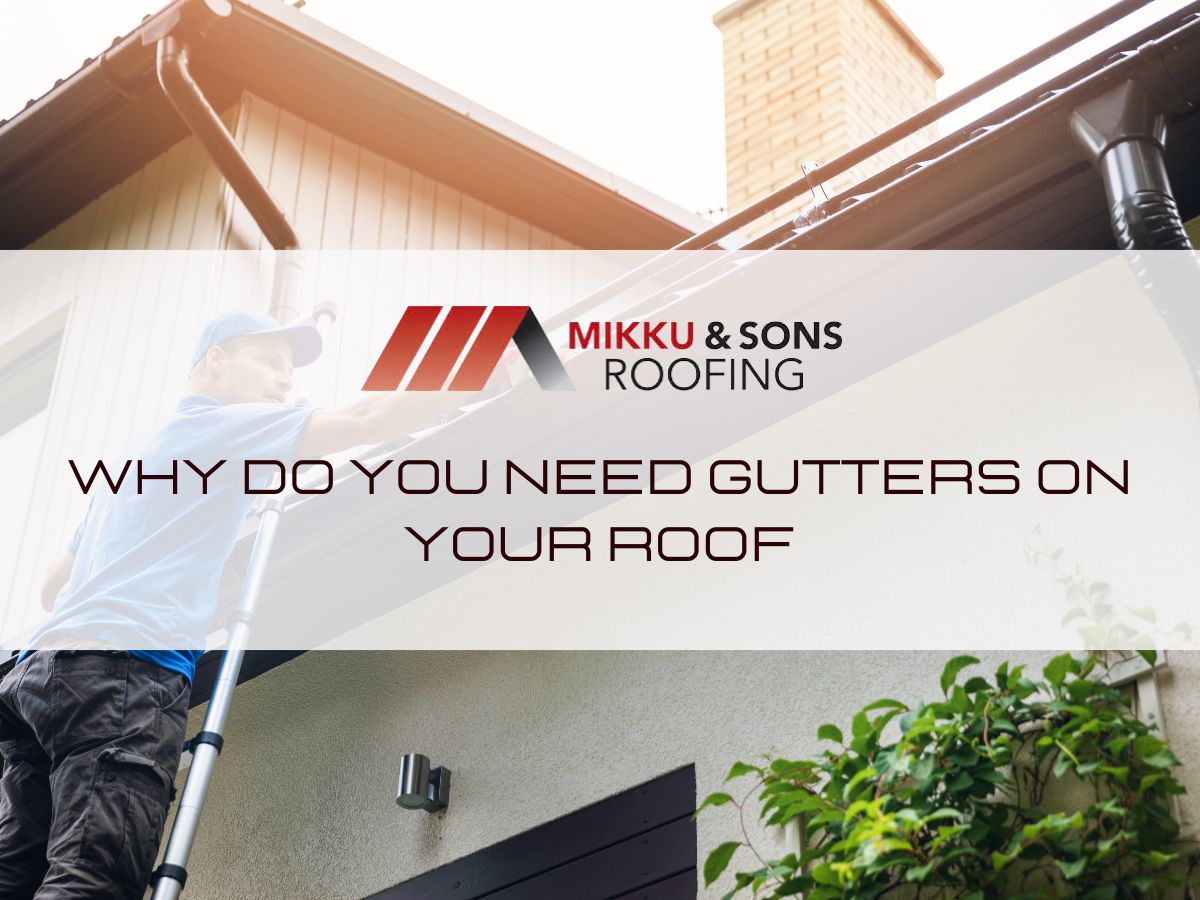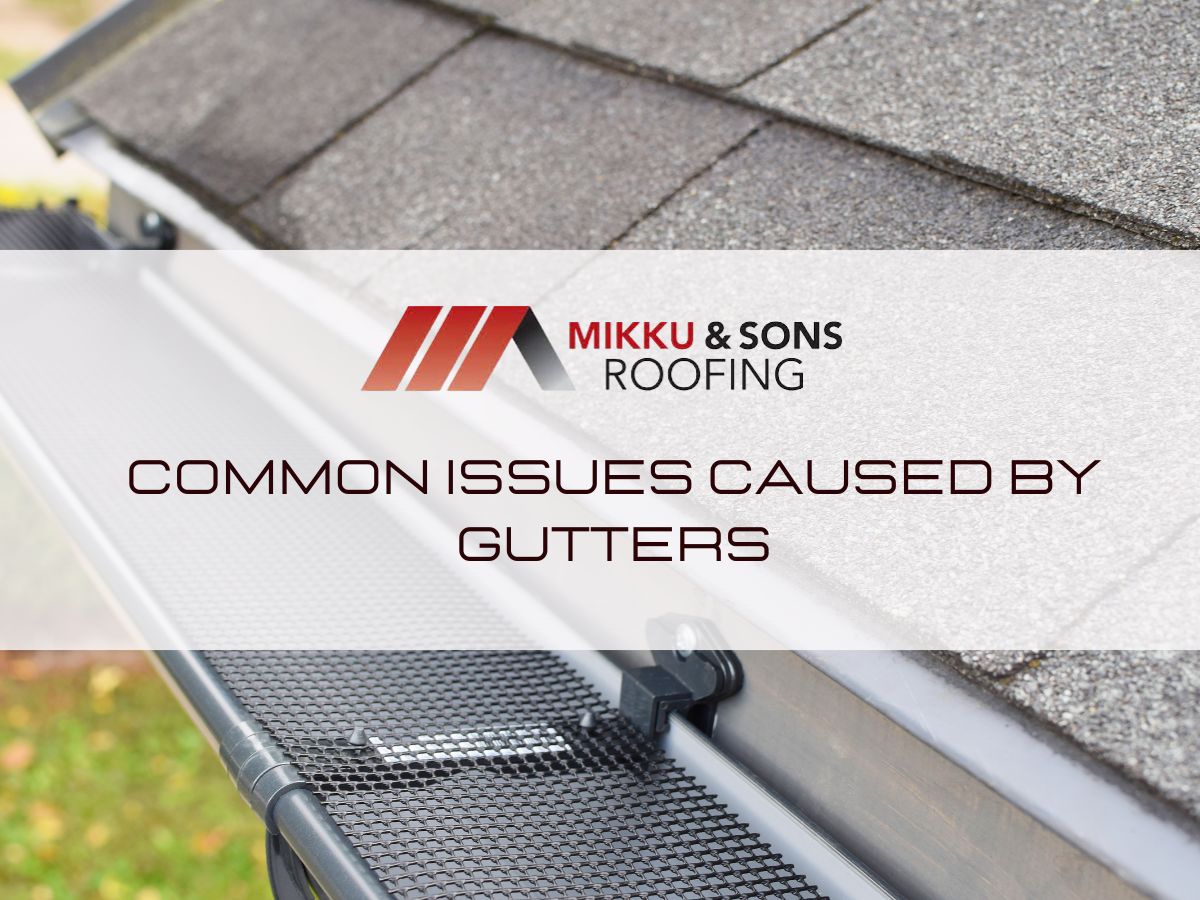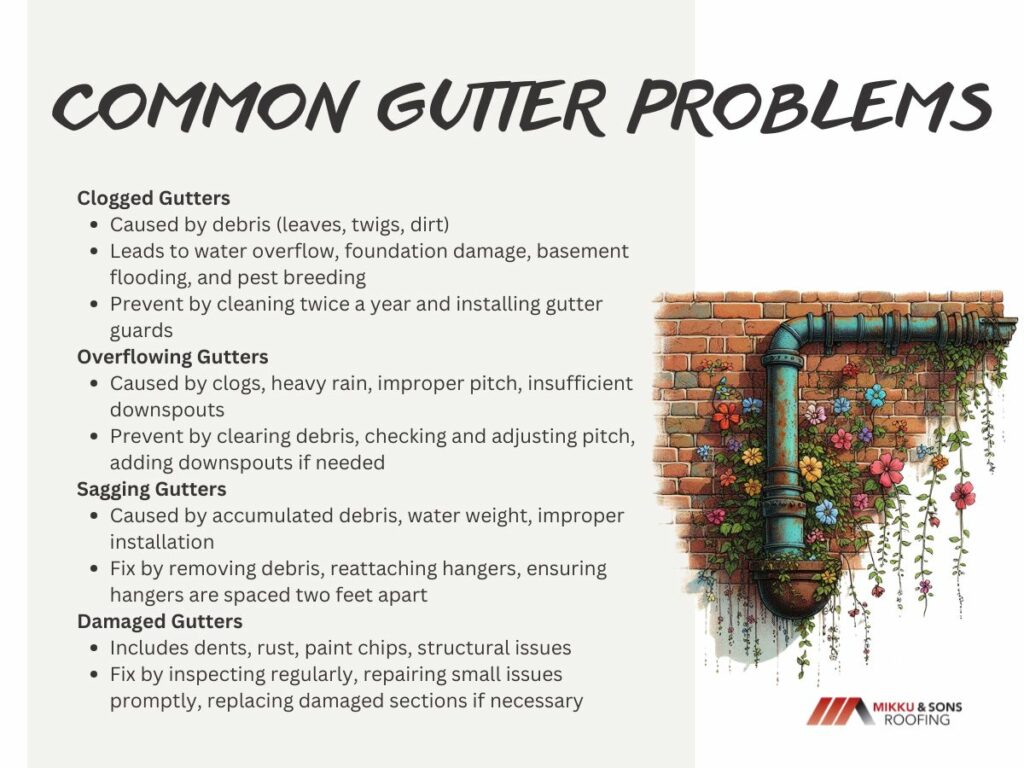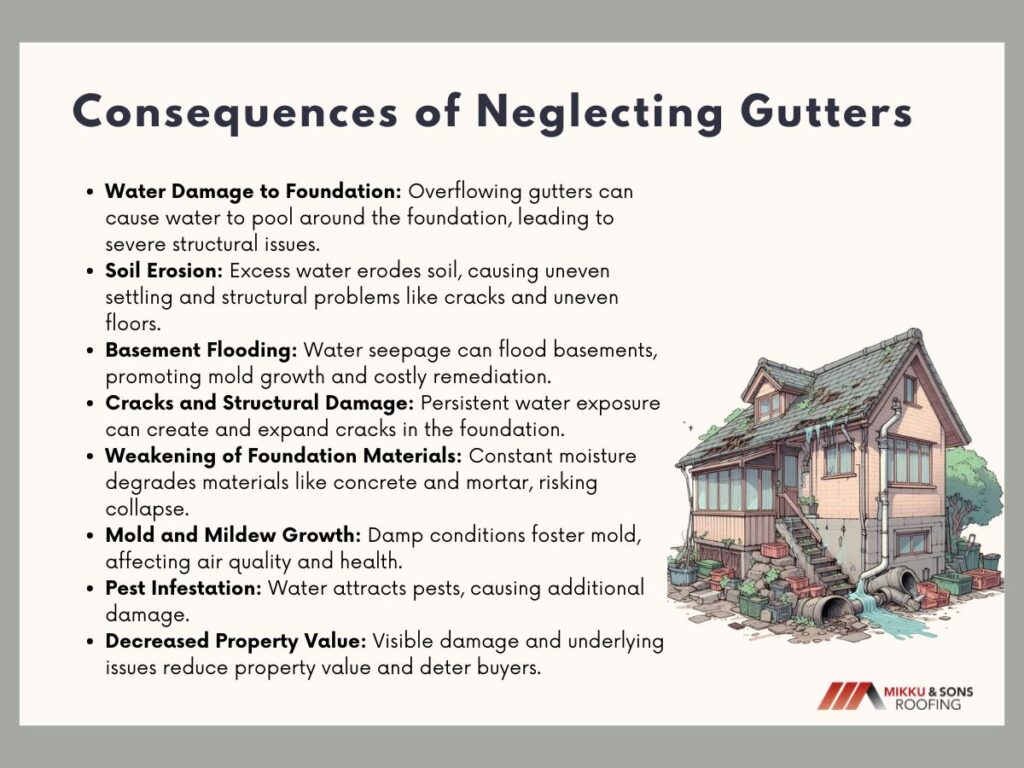

Neglecting gutter maintenance can have severe financial consequences for homeowners, particularly due to the high costs of repairs. Properly functioning gutters are essential for directing water away from your home's foundation. When gutters fail, water damage can lead to soil erosion, basement flooding, and significant foundation damage, necessitating expensive repairs.
The cost of repairing gutters varies based on the material and extent of the damage, with different materials incurring different repair costs. Understanding these costs can help homeowners make informed decisions about maintaining and repairing their gutter systems to avoid larger financial burdens. Below are the common issues caused by gutters.
Gutters play a crucial role in protecting your home from water damage by channeling rainwater away from the foundation. However, like any other part of your house, gutters can develop problems over time. Understanding these common issues can help you maintain your gutters and avoid costly repairs.

Clogged gutters are one of the most frequent issues homeowners face. This problem arises when debris such as leaves, twigs, and dirt accumulates in the gutter system. Over time, this debris can build up and form a dense blockage, preventing water from flowing through the gutters as intended.
The main consequence of clogged gutters is water overflow. When gutters are blocked, rainwater cannot pass through the downspouts and instead spills over the sides. This overflow can lead to a variety of problems, including damage to your home's foundation, basement flooding, and erosion of landscaping. Additionally, the stagnant water in clogged gutters can become a breeding ground for mosquitoes and other pests.
Regular maintenance, such as cleaning the gutters at least twice a year, can prevent clogs. Installing gutter guards can also help by keeping larger debris out while allowing water to flow freely.
Overflowing gutters are often a direct result of clogs, but there can be other contributing factors as well. When gutters overflow, it usually means they are unable to handle the volume of water they are receiving. This can happen during heavy rainfall or if the gutters are improperly pitched, meaning they do not have the correct slope to direct water towards the downspouts.
Another common cause of overflowing gutters is insufficient downspouts. If the downspouts are too few or too small for the size of your gutter system, they cannot effectively handle the water flow, leading to overflow.
To address overflowing gutters, first, ensure they are clear of debris. Then, check the pitch of the gutters and adjust if necessary. If the problem persists, consider adding more downspouts or increasing the size of the existing ones to improve water flow capacity.
Sagging gutters are another common issue that can lead to significant damage if not addressed promptly. Gutters sag when they become too heavy for the supports holding them up. This weight often comes from accumulated debris and standing water. Over time, the extra weight can cause the gutter hangers to loosen or pull away from the fascia board, leading to sagging.
In addition to debris and water weight, improper installation or poor-quality materials can also cause gutters to sag. If the hangers are spaced too far apart, they may not provide adequate support for the gutters, causing them to droop.
To fix sagging gutters, first, remove any debris and standing water. Then, check the hangers and reattach or replace them if they are loose or damaged. Ensure the hangers are spaced no more than two feet apart to provide adequate support. Using high-quality, durable materials for gutter installation can also help prevent sagging in the future.
Gutters can sustain various types of damage over time, affecting their functionality and appearance. Common types of gutter damage include dents, rust, paint chips, and structural issues.
Regular inspection and maintenance can help identify and address these types of damage early. Repairing small issues promptly, such as sealing cracks or repainting chipped areas, can extend the life of your gutters. In cases of significant damage, replacing the affected sections may be necessary to ensure the system continues to function properly.
Gutter maintenance is a critical aspect of home upkeep that is often overlooked by homeowners. Neglecting your gutters can lead to severe repercussions, most notably water damage to your home's foundation. Understanding the extent of this damage can highlight the importance of regular gutter maintenance.

The primary function of gutters is to direct rainwater away from your home’s foundation. When gutters are clogged, overflowing, or damaged, they fail to perform this crucial task. The result is that water can overflow and pool around the foundation of your house, leading to a series of serious and costly issues.
One of the first consequences of water pooling around the foundation is soil erosion. The excess water can wash away the soil that supports your foundation, leading to an uneven settling of the house. Over time, this can cause significant structural problems, including cracks in the walls and floors, uneven flooring, and doors or windows that no longer close properly.
Water that collects near the foundation can seep into the basement or crawl space of your home. This seepage can lead to flooding, which not only damages the interior of the basement but also creates a conducive environment for mold and mildew growth. Mold can spread rapidly, posing health risks to your family and necessitating expensive remediation efforts.
Continuous exposure to water can cause cracks in the foundation. These cracks can vary from minor hairline fractures to significant structural fissures. Over time, these cracks can expand, compromising the stability of your home. Repairing foundation cracks is often a complex and expensive process that can be avoided with proper gutter maintenance.
Water infiltration can weaken the materials used in your foundation. Concrete and mortar, for instance, can degrade when subjected to constant moisture. This weakening reduces the foundation’s ability to support the weight of your home, potentially leading to a partial or total collapse in extreme cases.
Moisture around the foundation encourages mold and mildew growth. These fungi thrive in damp environments and can spread into your home, affecting indoor air quality and posing health risks such as allergies, respiratory issues, and other illnesses. Mold remediation can be costly and disruptive, making it essential to prevent its growth by ensuring proper water drainage through well-maintained gutters.
Water pooling near the foundation creates a hospitable environment for pests such as termites, ants, and rodents. These pests can cause significant damage to your home by chewing through wood and other building materials. Additionally, some pests can create nests within the gutter system itself, exacerbating the clogging issue and leading to further water damage.
The cumulative effects of water damage can significantly decrease your property’s value. Potential buyers are likely to be deterred by visible signs of foundation damage, mold issues, and pest infestations. Even if you manage to sell the house, the value may be significantly reduced due to these underlying problems.
Neglecting gutter maintenance can lead to significant financial implications, particularly when it comes to expensive repairs. Among these, the most notable expense is the cost of foundation repairs. When gutters fail to direct water away from the foundation due to clogs, damage, or improper installation, water seepage and soil erosion can occur, leading to severe foundation issues.
Water that accumulates around the foundation can cause soil erosion, leading to an uneven settling of the house. Over time, this can result in cracks and structural damage to the foundation.
Repairing foundation damage can be extremely costly, often requiring the services of specialized contractors. The expenses can range from a few thousand dollars for minor repairs to tens of thousands of dollars for extensive damage. The process typically involves excavating around the foundation, stabilizing the structure with piers or other methods, and then backfilling and restoring the landscaping.
The financial burden of these repairs underscores the importance of regular gutter maintenance. By keeping your gutters clean and functional, you can prevent water from damaging your foundation, thus avoiding the high costs associated with extensive repairs.
The cost of repairing gutters varies based on the material and extent of the damage. Here is a breakdown of the average repair costs per linear foot for popular gutter materials, including labor:
Cost: $4–$8 per linear foot
Vinyl gutters are among the most affordable to repair. They are lightweight and relatively easy to handle, which keeps labor costs low. However, vinyl is less durable than other materials and may require more frequent repairs or replacement over time.
Cost: $5–$8 per linear foot
Aluminum gutters are a popular choice due to their balance of cost and durability. They are resistant to rust and can handle a significant amount of water flow. Repairs for aluminum gutters typically involve sealing leaks, reattaching loose sections, or replacing damaged segments.
Cost: $10–$18 per linear foot
Steel gutters are more robust than vinyl or aluminum, making them suitable for areas with heavy rainfall or snow. However, they are prone to rust, which can increase repair costs. Fixing steel gutters often involves treating rust, sealing leaks, and occasionally replacing sections that have corroded.
Cost: $25+ per linear foot
Copper gutters are known for their durability and aesthetic appeal, but they come with a higher price tag. Repairs can be costly due to the material's expense and the specialized skills required to work with copper. Common repairs include fixing leaks and replacing damaged sections.
Cost: $30+ per linear foot
Zinc gutters are highly durable and have a long lifespan, making them a premium choice. The cost of repairing zinc gutters is high due to the material's price and the expertise needed for proper repairs. Zinc gutters are less prone to rust and corrosion, which can offset the higher initial and repair costs over time.
Several factors influence the cost of gutter repairs, including:
Regular gutter maintenance is crucial for preventing costly repairs and protecting your home's foundation. Neglecting this maintenance can lead to severe financial implications, including expensive foundation repairs and varied costs associated with fixing different types of gutters.
By keeping gutters clean and functional, homeowners can avoid water damage, soil erosion, and the high expenses of extensive repairs. Understanding the repair costs for various gutter materials—ranging from vinyl to zinc—highlights the importance of proactive maintenance. Investing in regular gutter upkeep is a small price to pay for safeguarding your home and avoiding significant financial strain.
